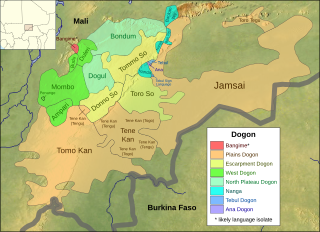Related Research Articles

The Niger–Congo languages are the world's third largest language family in terms of number of speakers and Africa's largest in terms of geographical area, number of speakers, and number of distinct languages. It is generally considered to be the world's largest language family in terms of number of distinct languages, just ahead of Austronesian, although this is complicated by the ambiguity about what constitutes a distinct language; the number of named Niger–Congo languages listed by Ethnologue is 1,540.

The Dogon are an ethnic group indigenous to the central plateau region of Mali, in West Africa, south of the Niger bend, near the city of Bandiagara, and in Burkina Faso. The population numbers between 400,000 and 800,000. They speak the Dogon languages, which are considered to constitute an independent branch of the Niger–Congo language family, meaning that they are not closely related to any other languages.

The Mande languages are spoken in several countries in West Africa by the Mandé peoples and include Maninka, Mandinka, Soninke, Bambara, Kpelle, Dioula, Bozo, Mende, Susu, and Vai. There are "60 to 75 languages spoken by 30 to 40 million people", chiefly in Burkina Faso, Mali, Senegal, the Gambia, Guinea, Guinea-Bissau, Sierra Leone, Liberia, and Ivory Coast.

The Dogon languages are a small closely-related language family that spoken by the Dogon people of Mali and may belong to the larger Niger–Congo family. There are about 600,000 speakers of its dozen languages. They are tonal languages, and most, like Dogul, have two tones, but some, like Donno So, have three. Their basic word order is subject–object–verb.
Escarpment Dogon is a continuum of Dogon dialects of the Bandiagara Escarpment, including the standard language. There are three principal dialects:
Jam Sai is one of the Dogon languages spoken in Mali, and the only one spoken in Burkina Faso apart from a few villages of Tomo Kan. It is one of the plains languages spoken in Dogon villages outside the Bandiagara Escarpment. It is a major language in Koro, at the south end of the escarpment, and stretches as far north as Douentza. It is not mutually intelligible with other Plains Dogon languages, but is widely known as the prestige variety due to its use as the language of radio broadcasts. Dialects are Domno tegu, Gono tegu, Bama tegu, and Guru tegu; their degree of mutual intelligibility has not been recorded. Domno is the standard dialect, and considered the purest; Guru (Koro) is the dialect of that town.
The Ijawlanguages, also spelt Ịjọ, are the languages spoken by the Ijo people in southern Nigeria.
Ana Dogon, or Ana Tiŋa, is a recently discovered Dogon language spoken in Mali. It was first reported online in 2005 by Roger Blench.
Budu Dogon or Bunoge, also known as Korandabo, is a recently discovered Dogon language spoken in Mali. It was first reported online. The plural suffix on nouns is closest to Kolum so, suggesting it should be classified as a West Dogon language.
Bankan Tey Dogon, at first called Walo-Kumbe Dogon after the two main villages it is spoken in, also known as Walo and Walonkore, is a divergent, recently described Dogon language spoken in Mali. It was first reported online by Roger Blench, who reports that it is "clearly related to Nanga", which is only known from one report from 1953.
Naŋa dama, also known as Naŋa tegu, is a Dogon language spoken in Mali that is only known from one report from 1953. Roger Blench reports that its nearest relative is the recently described Walo–Kumbe Dogon, "with which it shares both lexicon and the feature that many nouns have a final -m." Hochstetler thinks they may be the same language. It may be close to Yanda Dogon (Blench) or Jamsai tegu (Hochstetler).
Yanda Dogon is a Dogon language spoken in Mali. It is reported to be lexically similar to Nanga, which is only known from one report from 1953.
The Tebul language, also known as Tebul Ure, is a Dogon language spoken in Mali by the Tebul U. It was first reported under this name online by Roger Blench, who erroneously reported that it appears to be the same as a language called Oru Yille in the literature. This mistaken name instead means 'two words' in the Tebul language.
The Dogul language, Dogul Dom, is a Dogon language spoken in Mali. It is closest to Bondum Dogon, though not enough for mutual intelligibility.
The Bondum language, Bondum Dom, is a Dogon language spoken in Mali. It is closest to Dogul Dogon, though not enough for mutual intelligibility. Dialects are Kindjim and Nadjamba.
Duleri Dogon or Duleri Dom, also known as Tiranige dige, is a Dogon language spoken in Mali.
Ampari Dogon, also known as Ambange or Ampari kora, is a Dogon language spoken in Mali.
The Toro language, Tɔrɔ tegu 'Mountain speech', is a Dogon language spoken in Mali. It is closest to the prestige variety of Dogon, Jamsay tegu, though speakers deny they are related and understand little of it. Hochstetler report difficulties in comprehension between Tɔrɔ tegu and one of the western Plains Dogon languages, Tomo kan.
The Dogon dialects of the western plains below the Bandiagara Escarpment is Mali are mutually intelligible. They are sometimes called the Kan Dogon because they use the word kan for varieties of speech. The dialects are:
Penange Dogon is a Dogon language spoken in Mali. It is close to Ampari. The language was first described as distinct in 2011 by Prokhorov.
References
- ↑ Mombo at Ethnologue (18th ed., 2015)
- ↑ Hammarström, Harald; Forkel, Robert; Haspelmath, Martin, eds. (2017). "Mombo Dogon". Glottolog 3.0 . Jena, Germany: Max Planck Institute for the Science of Human History.
- Blench, Roger (2005). "A survey of Dogon languages in Mali: Overview". OGMIOS: Newsletter of Foundation for Endangered Languages. 3.02 (26): 14–15. Retrieved 2011-06-30..
- Hochstetler, J. Lee; Durieux, J.A.; E.I.K. Durieux-Boon (2004). Sociolinguistic Survey of the Dogon Language Area (PDF). SIL International. Retrieved 2011-06-30.
